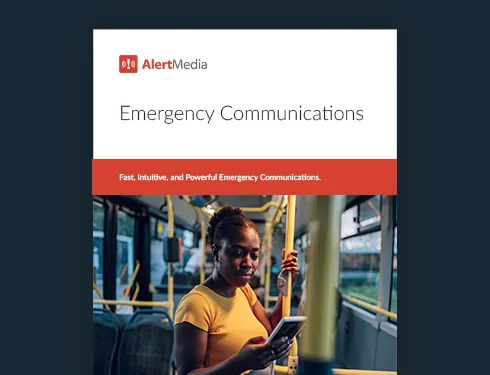
Maximize the Value of Your Emergency Communication Software
Modern emergency communication systems have many practical applications, helping facilitate communication during any event in which a large number of employees need information quickly.

When you hear the word “emergency,” what do you think of? Perhaps a fire or an active shooter in the workplace. Or an incoming Category 3 hurricane. Those types of emergencies—the ones that receive widespread media attention—present substantial risks to your organization and require a specific emergency communication plan designed to keep employees safe.
From a business perspective, however, there are many types of critical events that impact normal operations, and for these, your organization needs a similar emergency response plan. Fortunately, modern emergency communication systems have many practical applications, helping facilitate communication during any event in which a large number of employees need information quickly.
From traditional emergencies to a wide range of more common business events, a mass notification system can keep your people informed and connected.
Maximize the Value of Your Emergency Communication Software
Emergency communication software is designed to facilitate reliable, targeted communication during an emergency. But, the very same capabilities that make a modern communication system so effective during emergencies and catastrophic events can help your company tackle a number of other business-critical challenges
3 Critical Business Functions That Benefit From an Emergency Communication System
A modern emergency communication system allows you to quickly and reliably send messages out over multiple channels and easily solicit employees’ responses. It can help you segment your workforce in a variety of ways—by job title, office building, or even their real-time GPS location. It can instantaneously set up a conference call with any subset of your organization. And since everything is hosted in the cloud, you can leverage these capabilities from any location or device.
These powerful capabilities ensure that if your organization is faced with a threat like a fire, severe weather, or an active shooter, your communication will be fast, effective, and reliable. But, even if you aren’t faced with these emergencies, your organization can capitalize on the benefits of a modern emergency communication system in other ways.
From HR to Operations to IT, mass notification systems can be used across your organization to streamline the communication of business-critical information.
HR communications
As the leaders of the “people side” of the business, HR leaders have many demands on their time. They need an efficient, reliable way to deliver messages to the right groups of people quickly. HR can leverage emergency communication software to facilitate:
Open enrollment
Whether you are launching new benefit programs or not, open enrollment is always a significant undertaking requiring consistent communication throughout the process.
First, you need to communicate ahead of time so your employees know that the open enrollment period is coming and they should plan accordingly. Then, once it begins, you need to again notify employees that open enrollment has started, along with any program changes and deadlines.
AlertMedia can streamline this communication process from start to finish. By utilizing the survey feature, you can even identify which of your employees have already enrolled—and then target subsequent reminders to only those who have not yet completed their enrollment.
Wellness checks
Employee mental health is increasingly becoming a C-level priority—and rightfully so. With more employees working from home due to COVID-19, many are feeling the effects of isolation in the form of depression, anxiety, and burnout. With an emergency communication solution, HR teams can proactively and confidentially conduct employee wellness checks to better determine which employees need additional support.
Research shows that the pandemic has caused a surge in mental health and substance abuse issues, with at least 40 percent of Americans reporting struggling with mental health in a recent CDC survey. As we approach winter, mental health experts also warn that more Americans will likely experience seasonal affective disorder (SAD)—also known as seasonal depression. Conducting regular wellness checks can help HR teams ensure all employees have access to the mental health support they need to cope.
Policy announcements
When a company policy changes, it is HR’s responsibility to ensure impacted employees understand what is changing, why, and how it will impact their jobs.
COVID-19 has forced many companies to rapidly change policies related to remote work, travel, and health and safety. These policies are continually evolving to reflect new regulations, the latest information and guidance, and changing workplace attitudes. With policy changes becoming more frequent, a mass notification system is an increasingly valuable tool in HR’s technology toolbox.
By sharing policy updates in a timely, transparent way—and enabling a two-way dialogue about those changes—HR can create a better employee experience. Using AlertMedia’s dynamic groups, HR teams can easily segment messages by job function, location, or any other relevant attribute. And, by automatically syncing with your HRIS or Active Directory, you never have to worry about outdated employee contact information.
Business operations communication
Emergency communication software can help organizations inject timely, secure notifications into their operational and logistical processes. Operations teams can use a mass notification system to improve efficiencies and more effectively coordinate:
Logistics
Automating operational alerts can be an extremely powerful tool. For example, trucking companies can integrate their mass communication software into their internal systems to better synchronize the arrival of delivery trucks to their loading bays. One AlertMedia customer with a retail delivery fleet uses AlertMedia to auto-notify locations when a shipment is about to arrive, enabling them to load and unload quickly, which saves time and money.
Whether you need to send safety alerts to field technicians, travel advisories to drivers, inform your people of an operational issue, or more effectively coordinate shipments and deliveries, an emergency communication system is an invaluable asset to your organization’s operations function.
Facility and maintenance notifications
In every organization, there are times when everyone in the office needs to be on the same page. Maybe there’s been a last-minute decision to close due to severe weather, or perhaps there is disruptive maintenance in one portion of the building.
In these situations, email and other non-critical communication channels aren’t going to get the job done. If it’s 7:00 a.m. and you’ve decided to close the office, sending out a mass email to the company listserv may reach some of your people. But many others are already getting in their cars or won’t check their email until they get to the office.
In these moments, you need the ability to reach employees wherever they are and on whichever device they have on hand. This is where your emergency communication system comes in. With AlertMedia, you can quickly and reliably send out push notifications and text messages company-wide. And because the system allows for two-way communication, you can easily collect and respond to any questions from employees without switching between multiple tools.
System testing
During an emergency, mass communication software can streamline your company’s response—whether that means protecting key assets, minimizing office downtime, or keeping your people safe. But the fact is, if you aren’t comfortable using the system, you risk defaulting back to your standard communication outlets in an emergency.
By sending test messages—to different groups, over different channels, with different content—you can identify what is working as intended and what is not. Did someone not receive the message that you expected to? Maybe they need to be added to that group within your HRIS. Are you comfortable reading the results of a survey and responding to people within the system? The best way to find out is to send a message and see for yourself.
Increasing familiarity with the system in non-emergency contexts will ensure that when an emergency does arise, you will be ready.
IT and business systems communication
Companies’ IT departments can use mass notification software to communicate with employees about planned downtime, security breaches, helpdesk tickets, cyber threats, outages, and more. Here are a few ways the robust functionality of an emergency notification solution can streamline IT operations:
Unplanned system outages
For most companies, IT outages qualify as an emergency. Even though they might not threaten personal safety, their impact on business continuity can be enormous. Most business operations grind to a halt during an internet outage, and an extended power outage can cost businesses millions in lost sales and productivity.
During a system outage, email is often inaccessible by employees. In fact, IT might not even be able to send a message. With an emergency communication system, IT leaders can quickly send notifications across multiple channels—using pre-built notification templates if they wish—using AlertMedia’s full-featured mobile app. And since many IT issues are user- or location-specific, IT teams can segment notifications so only impacted employees receive the message.
Security breaches
If your organization is on the receiving end of a cyber-attack or phishing scheme, relying on email as the only communication channel would not only be useless, but likely counterproductive. An emergency communication system with multi-channel communication capabilities allows IT teams to rapidly notify employees of security incidents via text, email, voice call, mobile app pushes, and even desktop takeover. An emergency communication system can also send automated notifications to on-call IT staff for help, escalating to senior management if necessary.
Finding the Right Uses for Your Notification System
These less obvious (but no less valuable) uses for your mass notification solution are just a starting point. There’s no limit to the ways that a dynamic communication system like AlertMedia can benefit your organization. Every business is unique—and only you know how to best integrate an emergency communication system into your business.
If you want to maximize the ROI from your mass notification software, the first step is shifting your mindset. Instead of seeing it as an emergency-only tool, think about how it can improve all of your business-critical communication. By looking for new ways to extend the capabilities of your mass communication system, you can get more value out of it, improve business continuity, and enhance your everyday business operations.

![11 Steps to Creating an Effective Emergency Response Plan [+ Template]](https://www.alertmedia.com/wp-content/uploads/2023/10/Blog-Emergency-Response-Plan.webp)


